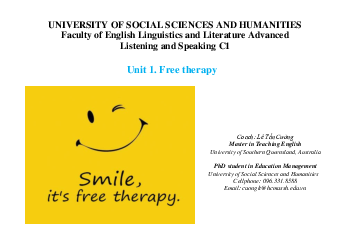


Preview text:
lOMoAR cPSD| 41487872 BIOMIMICRY
Biomimicry is a fascinating field that explores how nature can inspire us to create more
sustainable and innovative solutions for human challenges. Here are some more things you
might want to know about biomimicry:
Biomimicry can be applied at different levels of design, from mimicking the form,
function, or system of a specific organism, to mimicking the principles or patterns of nature as a whole.
Biomimicry can help us address some of the most pressing global issues, such as
climate change, water scarcity, food security, energy efficiency, waste management, and biodiversity loss.
Biomimicry can also foster a deeper appreciation and respect for nature, as we learn
from its wisdom and innovation, and align our human systems with the natural systems.
Biomimicry is not only a scientific or technical approach, but also a creative and
artistic one, as it requires imagination, curiosity, and interdisciplinary collaboration.
Biomimicry is not a new idea, but a rediscovery of an ancient practice that many
indigenous cultures have been following for centuries, by observing and learning
from nature’s cycles and rhythm
. What are some examples of biomimicry?
Biomimicry is the practice of looking to nature for solutions to modern problems. Some examples of biomimicry are:
Velcro, which mimics the hook-like surface of burdock seeds.
The Beijing National Stadium, which was inspired by the shape and structure of a bird’s nest.
The Shinkansen bullet train, which was designed to reduce noise by copying the
shape of a kingfisher’s beak.
The Eastgate Centre in Zimbabwe, which uses passive cooling based on the
ventilation system of termite mounds.
The Eiffel Tower, which was influenced by the anatomy and stability of human bones
. What are the advantages of biomimicry?
Biomimicry has many advantages, such as: lOMoAR cPSD| 41487872
It can help us create more efficient, sustainable, and resilient products, processes, and
systems that are well-adapted to life on earth.
It can inspire us to learn from nature’s wisdom and innovation, and foster a deeper
connection and respect for the natural world.
It can offer solutions that are compatible with the principles of circular economy,
biomimicry, and cradle-to-cradle design, which aim to eliminate waste and pollution,
regenerate natural resources, and create positive social and environmental impacts
. In which kinds of jobs might micro-robots be useful?
Micro-robots are tiny robots that are often developed for research purposes or specific uses
in the biotech industry, such as diagnostics and treatment. They can also be useful in other fields, such as:
Environmental monitoring and remediation, where they can detect and remove
pollutants, contaminants, or invasive species.
Search and rescue, where they can access hard-to-reach areas, locate survivors, and
deliver supplies or medical aid9.
Engine inspection, where they can check for faults, cracks, or corrosion in complex machinery.
Agricultural research, where they can collect data, monitor crops, or pollinate plants9
. How does biomimicry contribute to a more sustainable world?
Biomimicry contributes to a more sustainable world by:
Providing solutions that are based on nature’s time-tested patterns and strategies,
which have evolved over millions of years to optimize energy, material, and information flows.
Encouraging conservation for ecosystems and their inhabitants, because they hold the
knowledge we need to survive and thrive.
Promoting a shift in mindset from viewing nature as a source of raw materials to
viewing nature as a source of inspiration and mentorship.
Enabling a transformational change in the way we design, produce, and consume, by
aligning our human systems with the natural systems lOMoAR cPSD| 41487872 Phrases:
Biomimicry is the practice of learning from and imitating nature’s designs
and processes to solve human problems
Biomimicry is innovation inspired by nature1
Biomimicry is the conscious emulation of life’s genius2
Biomimicry is not meant to be taken as an end-all, be-all; it serves as
inspiration within a set of limitations3
Biomimicry is known for its design applications. But biomimicry also has
an abundance of business applications4
Biomimicry is basically taking a design challenge and then finding an ecosystem
that’s already solved that challenge, and literally trying to emulate what you learn.




